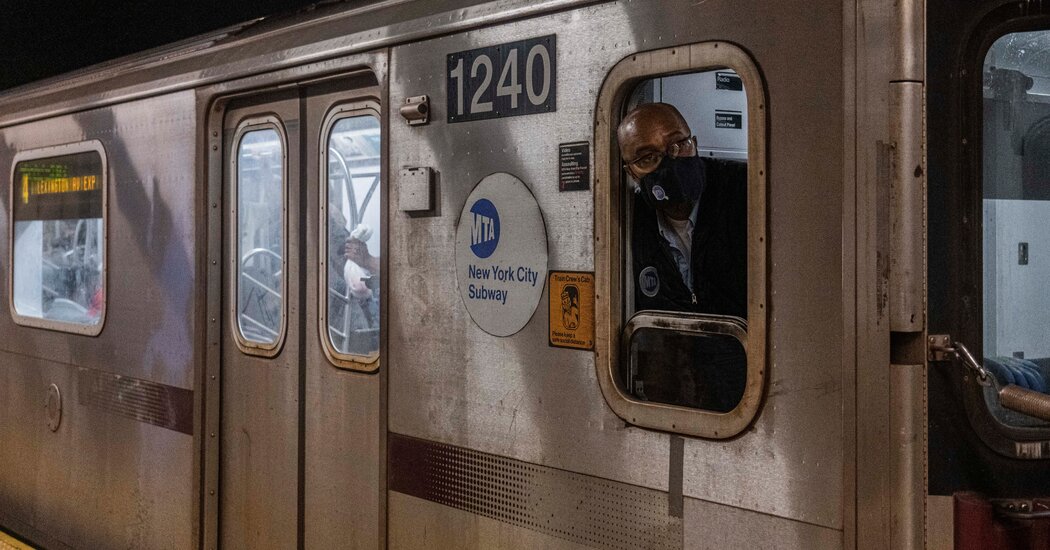
Good morning. It’s Friday. Today we’ll look at the role of conductors in New York City subway trains.
For more than a century, nearly every New York City subway train has been staffed by a two-person crew: an operator, who drives the train, and a conductor, who controls the doors and makes announcements.
My colleague Stefanos Chen wrote about a bill being considered by Gov. Kathy Hochul that would keep the two-person crews on subway trains indefinitely, even as major transit systems around the world are cutting back on the number of workers aboard trains — and sometimes fully automating service.
How do other cities do it?
The New York City subway system is an outlier when it comes to staffing on trains.
Out of 400 train lines in over a dozen countries in Europe, Asia and North America, only a fraction — just 6 percent — still staff train cars with two people, according to a recent study from a think tank at New York University’s Marron Institute of Urban Management. Most have just one person, or no one at all, on board, or have plans to reduce the number of on- board staff members.
Conductors make the subway safer, proponents say
Even if the rest of the world is doing it, reducing the number of staff members on New York City subways could be a politically tricky proposition. Crime in the subway is rare, according to Police Department statistics, but the White House has portrayed the city’s subway system as dangerous, and the issue has become a political flashpoint.
Mayor Eric Adams and Governor Hochul have deployed police officers and the National Guard to the subways in recent years to address concerns about safety.
John Samuelsen, the international president of the Transport Workers Union, which represents subway conductors, said two-person crews were a deterrent to crime and a necessity when trains needed to be evacuated.
The presence of a conductor makes trips “visibly safer,” he said.
Ms. Hochul is up for re-election next year, and union support, including support from transit labor leaders, is likely to be important in her run.
Eliminating conductors could save money and improve service, opponents say
The M.T.A. employs about 3,600 subway train conductors, who are paid an average of $38 an hour. If the authority transitioned to one-person train operation, it could save over $440 million a year, as more conductors retire or shift to different jobs, according to Andrew Rein, the president of the Citizens Budget Commission, a watchdog group.
The savings would come at a time of financial strain — the M.T.A. could face an $800 million cash shortfall starting in 2030, he said.
The bill Ms. Hochul is considering would also require the M.T.A. to hire conductors for the small number of lines operating without them, which would cost an additional $10 million per year.
Impact on remote systems
The bill could affect other M.T.A. projects. The organization has invested heavily in a new signal system, called communications-based train control, or C.B.T.C., which is designed to control trains remotely and allow more frequent service.
In April, the state approved $5.4 billion to be spent on the system, and billions more are expected to be raised through congestion pricing toll revenue.
But if the bill is passed, the M.T.A. would be prohibited from shifting to one-person operation on those and other trains, said Rachael Fauss, senior policy adviser at Reinvent Albany, a watchdog group.
“It’s kind of flushing the benefits of C.B.T.C. down the toilet,” she said.
Weather
Expect a mostly sunny day, with a high near 50. Tonight will be partly cloudy, with a low around 36.
ALTERNATE-SIDE PARKING
In effect until Nov. 27 (Thanksgiving).
The latest Metro news
- Penn Station’s troubled past, present and future: The transit hub frequented by over 600,000 people daily is afflicted by century-old infrastructure, and will continue to be unless politicians, agencies and James L. Dolan, the billionaire whose company owns Madison Square Garden, can reach an agreement.
- Gov. Kathy Hochul’s vetoes: The governor voted down seven seemingly unrelated bills, all sponsored by the same state senator, James Skoufis, a moderate Democrat representing most of Orange County. The vetoes seemed intended to send a message.
- Controversy over permit approvals: Gov. Kathy Hochul should have recused herself from decisions to grant permits that would benefit clients of the law firm where her husband works, activists and two state lawmakers said.
New Jersey
- A representative’s criminal case proceeds: Monica McIver, a New Jersey congresswoman, must return to court on an assault charge after a federal judge ruled she did not have constitutional protection during her visit to a detention center in Newark. McIver was accused of assaulting federal immigration agents outside a jail in Newark.
- Man sought for bringing bat to Alina Habba’s office: The man brought a baseball bat to the office of the acting U.S. attorney in New Jersey, two people familiar with the matter said.
- Betting ring was backed by the Mafia, the authorities say: Fourteen people were charged with taking part in a multimillion-dollar betting ring in New Jersey that involved student athletes who ran their own illegal sports books.
METROPOLITAN diary
Which Way to Go?
Dear Diary:
I was on an eastbound 23rd Street crosstown bus when the driver got on the public address system.
“Anybody know where Gramercy is?” he asked.
Luckily, several riders did.
— David Goodman
Illustrated by Agnes Lee. Tell us your New York story here and read more Metropolitan Diary here.
Glad we could get together here. C.B.
P.S. Here’s today’s Mini Crossword and Spelling Bee. You can find all our puzzles here.
Lauren Hard, Tara Terranova and Ed Shanahan contributed to New York Today. You can reach the team at [email protected].
Sign up here to get this newsletter in your inbox.
Camille Baker is a Times reporter covering New York City and its surrounding areas.
The post Why a Bill on the Governor’s Desk Is a Tough Call appeared first on New York Times.



